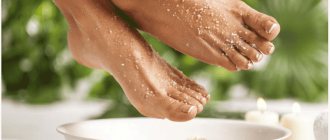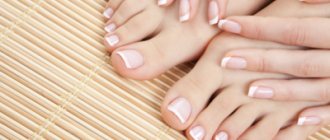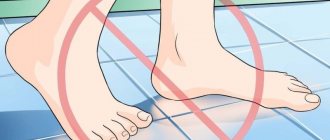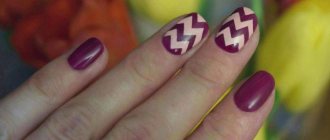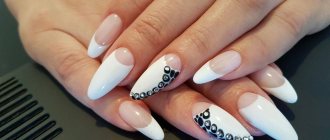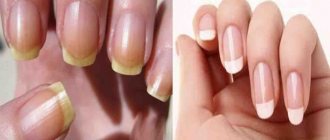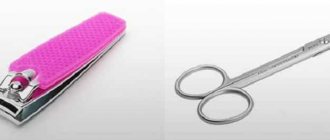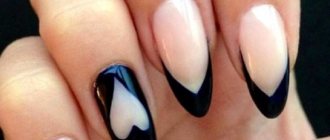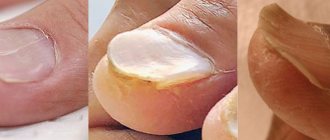A healthy human nail is thin, smooth and shiny. The nails on the feet are somewhat thicker than on the hands. With age, the nail plates become coarser and become denser. It is difficult to cut them, so they use products that help make them soft.
Thickening, accompanied by deformation of the plate, discoloration, crumbling, peeling of the periungual area - all this indicates onychomycosis. This is nail fungus. Taking care of your nails with this disease is even more difficult. And cutting your hair turns into torture. There are many reasons for thickening nails. These include fungal infection, poor diet, and wearing shoes that don't fit properly. In older people, hard nails are normal. You can cut your hair only after steaming it in a hot bath.
How to soften toenails in older people and why do it? What drugs and remedies will help make nails soft with fungal infection? We will answer these questions in detail.
Why do my toenails become hard and yellow?
There are many reasons why toenails thicken, become harder and acquire a yellowish tint. Some causes can be eliminated without the intervention of doctors, others only with the help of a professional doctor.
- Nail fungus . Fungal disease is a common cause of this type of problem. Such an infection simply cannot be ignored. Because the nails become much thicker, plus they change their shade. There is also pain at the site. The skin near the nail itches and swells. And the feet themselves give off an unpleasant odor.
- Stressful situations and poor diet. Severe stress can significantly weaken the human body. A busy schedule at work and strong emotions very often lead to mental distress. Nails become thicker, turn yellow, and also change their shape, peel and break. Often small depressions or growths appear. The whole situation can be aggravated by a disrupted diet: after a strict diet or overeating.
- Diseases in the body. Nails become thicker, loose and deformed very often due to eczema or psoriasis. If the nail has become thicker, yellowed, or changed shape, then you need to think about circulatory problems. This may be caused by a bacterial disease, metabolic disorder, or diabetes.
- Blood circulation is impaired due to rather tight shoes and improper walking. Problems may still be hidden in a family-inherited skin disease, for example, polykeratosis. Due to a lack of keratin, nail plates become thicker and denser over time.
Elderly people are also advised to wear only comfortable, flat shoes. If the nail begins to grow into the skin, you will need to visit a doctor, since such a problem can lead to an inflammatory process. At home, you can steam your legs and try to remove the appendage.
When and why you need to soften your nails
Curing nail fungus is quite problematic, sometimes it takes several months, and in some cases, therapy lasts a whole year. One of the points of successful treatment is the regular cutting of overgrown nail plates, but if the nail affected by the infection is too hard, and even deformed, it is very difficult to perform the manipulation.
Important!
Before treatment with an antimycotic drug, the nail must be softened, the overgrown part must be removed as much as possible, and the remaining plate must be thoroughly sanded with a nail file. This procedure will allow the drugs to penetrate deep into the tissues, thereby increasing their effectiveness.
But not only fungus can cause thickening of the nail plate - this problem is often observed in older people. Decreased immune defense, metabolic imbalance, lack of vitamins, microelements and other useful substances, deformation of the limbs, all this can cause roughening and thickening of the nails.
And if an elderly person also suffers from a fungal infection, the problem gets worse - it is impossible to cut off the plate without prior preparation.
Fungal infection causes nails to become hard and crumble when cut, leaving sharp edges that can subsequently grow into the skin, causing serious discomfort.
Conclusion - there are two significant reasons for softening nails:
- Increasing the effectiveness of antimycotic therapy;
- Prevention of plate ingrowth into soft tissues.
There are many proven methods that will help make your nails softer.
Softening of toenails in older people
Thickening of the nail plates in older people occurs due to deformation of the feet and salt deposition in the body. An old person needs to carefully care for their feet so that their nails do not grow into the skin.
It is best to use the following methods:
- Applying compresses with aloe. This plant can moisturize even very hard, thick and old nails. Compresses can be made directly from the leaves of indoor aloe. For this procedure, you will need to place pieces of the plant on the nail plates and secure with adhesive tape.
- The use of celandine and iodine. It is necessary to mix these ingredients and apply them to keratinized nails. The mixture should be kept for 15-20 minutes.
- Using ultra-nourishing gel. Not every softening cream can cope with hard nails of pensioners. For these purposes, only deep-acting agents can be used.
Folk remedies
Fungal infections cause serious discomfort to a person. Microorganisms that have settled under the nails gradually multiply, releasing their mycelia into the surrounding tissues. If the pathology is not treated promptly, it will quickly spread to other nail plates and the skin of the foot. Mycosis first affects the open end of the nail, eventually moving to its root, so in order to avoid the growth of the fungus, doctors advise removing the affected fragments of the plate. Below we describe how to soften the nail on the big toe using various folk recipes.
Chamomile
This medicinal plant perfectly disinfects and has a calming effect, thereby eliminating discomfort and irritation. A bath with chamomile decoction helps to gradually soften rough nail tissue for its subsequent removal. Prepare the product as follows:
- 6 tbsp. l. dry chamomile is boiled in 2 liters of boiling water;
- the broth is infused for 2 hours, then filtered with gauze;
- the liquid is boiled again, cooled slightly and used as a foot bath;
- The procedure is carried out daily for 20 minutes.
Vinegar
If the nails become rough, thickened or deformed due to mycosis, they must be removed. To facilitate this process, you can use regular table vinegar. You can prepare the product like this:
- soak cotton swabs in a 9% vinegar solution;
- then they are applied to the affected plates;
- The compress should be secured with a band-aid and left for 3-4 hours;
- treat the plates with vinegar daily, after which they try to cut them off as much as possible.
Tea mushroom
According to reviews, kombucha compresses are an effective antifungal agent that helps remove the affected plate in a few days. The folk method, in addition, eliminates itching, irritation and other unpleasant symptoms of the disease. The tool is used as follows:
- cut soft fresh kombucha into small slices 3-4 mm thick;
- apply pieces of the product to the nail plates and secure with a bandage or plaster;
- leave the compress on all night, rinse your feet with water and vinegar in the morning.
Aloe
There are several options for using the plant in the treatment of fungal infections: adding aloe juice to a cosmetic cream, preparing a paste from the leaves for treating plates, etc. The simplest method to help soften nail tissue is a micro-compress with aloe. It is prepared as follows:
- a piece of plant leaf is washed and cut lengthwise;
- the wet side is applied to the sore area, secured with an adhesive plaster;
- the next morning, remove the compress and easily cut off the nail plates.
Foot baths
The most popular way to soften hard toenails is with hot foot baths. After the procedure of steaming your feet, the nail plates soften and are easy to trim.
For better results, you can do one of the following baths at home:
- Soap and soda bath. Softens, relieves inflammation, has an antimycotic (antifungal) effect. You will need soda (3 tbsp.) and tar soap shavings (3 tbsp.). Warm 5 liters of water (not higher than 50C), add a soap-soda mixture, soak your feet for 20 minutes. This and all subsequent procedures are recommended to be performed every day for a week.
- Essential oil. The product helps soften the plate and has anti-inflammatory and antimycotic activity. It is best to use extracts of tea tree, patchouli, eucalyptus, and lavender. It is enough to add 3-5 drops of ether to warm water (2-3 liters) and lower the legs there for 20 minutes.
- Hydrogen peroxide. The product fights fungus, softens rough nail plates, calluses, and corns. Pour 5 tbsp into hot water (2 liters). l. peroxide. The procedure takes no more than 15 minutes. It is recommended to perform manipulations every other day, after which lubricate the feet with cream.
- Vinegar baths. The product softens nails and also fights the causative agent of the disease. Pour a glass of vinegar (250 ml) into warm water (2 liters), dip and soak your feet for 10-15 minutes.
- Herbal collection. Chamomile, sage, celandine and St. John's wort (1 tablespoon each) pour boiling water (2 liters), leave for about an hour. Strain the infusion and add the same amount of warm water. Carry out the procedure for about 20 minutes.
The time for bathing procedures is 15-20 minutes, until the water cools completely. During this time, the nails will become soft and can be easily cut off. It is worth noting that it is not recommended to add sea salt to the nail softening bath, as this procedure helps strengthen the nail plate.
Ointments for softening the nail plate
There are several options for preparing an ointment to soften the nail. It contains components that have a keratolytic effect.
Salicylic ointment
Salicylic ointment contains an active ingredient in the form of an acid. It has a pronounced exfoliating effect, which is necessary to soften the nail affected by fungus. This ointment is sold in pharmacies.
Terms of use
To achieve the desired result, you must apply 5% ointment. You should take a small amount of ointment and apply it to the affected area. It is recommended to use this product after a foot bath. Leave the ointment on the nail for half an hour. If the plates were previously steamed, then the ointment should be left for 15 minutes.
Accordingly, the top must be coated with polyethylene. After the procedure, remove any remaining ointment.
Homemade ointment
At home, you can prepare an ointment to soften the nail plate. All ingredients are thoroughly mixed together. For the ointment, you need to take beeswax, salicylic acid and aloe vera juice. After mixing the ingredients, the mixture is left in the refrigerator for several hours.
Terms of use
Before using the ointment, it is recommended to take a foot bath with the addition of chamomile or celandine. Next, take the prepared ointment and put a small amount on the nail. Wrap the top tightly with a bandage and polyethylene. Leave for 30 minutes, then carefully remove the product.
Compresses
If an elderly person is unable to take a foot bath due to illness or other reasons, then you can soften a thick toenail at home using compresses:
- Compress using aloe. Wash the leaf torn from the plant and cut it. Apply the inner part to the nail. Secure the leaf with cling film, bandage or adhesive tape. It is better to apply this compress at night and remove it in the morning.
- Tea mushroom. Place a piece of mushroom on the problem area and secure with cling film or bandage. After 8 hours, the bandage can be removed. Trimming your nails after this procedure will be easy.
- Vinegar and vegetable oil. Both ingredients are mixed in equal proportions, soaked in gauze cloth and applied to the affected nail. They also wrap it in film, put on socks, and leave it overnight;
- With vinegar. Soak a cotton pad in apple cider vinegar or 9%. Apply to the damaged nail and wrap your foot with cling film, wearing a warm sock. After 4 hours, you can remove the compress. Next, wash your finger with clean water and apply nourishing cream.
What softens the nail?
Patients faced with onychomycosis are interested in the question “how can you soften toenails with fungus?” There are many ways that can make the nail plate softer, increase the effectiveness of antifungal therapy, and prevent deformation and ingrown nails. These include:
- Taking specialized pharmaceutical drugs.
- Performing special foot baths.
- Applying softening compresses.
If the disease is mild, when the fungus affects the nails of only 1 or 2 fingers, you can cope with the problem yourself, using home remedies for these purposes.
Ointments and creams
To soften your toenails, you can use store-bought creams or ointments or prepare them yourself:
- Vitamin softening cream. Add 1 teaspoon of olive oil, vitamin E and vitamin A to any nourishing fatty cream, apply to rough areas every day and file off the softened areas. This method is mainly used in the initial stages of thickening the nail plate.
- Homemade ointment. Take melted butter, natural beeswax, an onion, a clove of garlic and an aloe leaf. All components are finely chopped and mixed. The mixture is heated in a water bath for about 3 minutes, then left to cool. The feet are steamed in hot water for 15 minutes, wiped dry, ointment is applied to the nail plates, and the feet are wrapped in film and a warm blanket. The ointment is left on the nails overnight. In the morning, nails are trimmed. If the ossified tissue has not softened enough, the procedure is repeated up to 3-5 times.
- Ichthyol ointment or Vishnevsky ointment. For purulent inflammation and ingrown nails, ointments are applied according to the salicylic principle. They are also effective nail plate softeners.
- Salicylic ointment. The pharmacy sells 5% ointment, which is used when the nail plate is affected by fungus. The ointment is applied in a thick layer as a compress in the morning and evening after steaming the legs in a bath with manganese, soda or soap. The bandage is kept for 1 hour. Then remove the remaining ointment with a soft cloth.
- Uroderm ointment. A strong product containing urea, which can quickly soften keratinized areas. The ointment is applied to the thickenings 2 times a day in a thin layer. In advanced cases, an occlusive dressing is used. For fungal infections, the product is applied half an hour before applying topical fungicidal agents.
- Nailitis. A specially developed product that helps soften nails and trim affected areas without pain. The drug is applied after using a soda-soap bath. Apply it only to the nail, without touching the surrounding areas of the skin, seal it with a band-aid and leave it in this form for 3-4 days. After the specified time has passed, the patch is peeled off, a steam bath is taken again, and the soft parts of the nail plates are filed off.
- Kanespor complex. Consists of an anti-fungal preparation, a set of plasters and a scraper. The product is intended to combat thick nails and onychomycosis. The nail plate is treated with the healing solution once a day in accordance with the instructions for use. Within 7-14 hours, the nail completely softens and is removed, covering the wound with a bandage. The patch needs to be changed to a fresh one every day.
All the methods and techniques described above are aimed at eliminating the problem of hard and thick nails and alleviating the condition. But you definitely need to get rid of the reason that provoked this trouble, otherwise all efforts will bring only a temporary effect.
Preparations for softening nails
To treat fungus, you can use economical homemade folk remedies, but to get quick results, it is better to turn to effective pharmaceutical remedies. Medicines that help soften the nail plates usually have a complex effect, simultaneously nourishing, healing, and saturating them with vitamins. All pharmaceutical preparations for removing fungal tissues are divided into 3 types:
- ointments, creams;
- varnishes;
- solutions.
The main difference between the listed funds is their structure. Thus, the varnish does not need additional protection, since it itself performs a protective function. Moreover, the use of the drug in this form will be effective only if the nail tissue is slightly affected by mycosis (more than 15-20% of the total area). All products for releasing the nail bed, be it ointments, creams and solutions, as a rule, contain urea (carbamide) - a substance that softens the plate well, helping to remove it non-surgically.
Liquid
Before softening toenails with fungus using one of the remedies described below, you need to consult a dermatologist and do a test for an allergic reaction to the components of the selected solution. The toenail softener is applied to pre-cleaned feet, and the liquid is applied exclusively to the areas affected by the fungus. The most popular antimycotic medicinal solutions are:
- Dimexide. The liquid is also used to eliminate onychomycosis in the initial stages of the disease. The advantage of the solution is the simple process of use, high efficiency, and affordable price. The disadvantage is the need for long-term use to achieve the expected result.
- Exoderil. An antifungal agent in the form of a solution helps not only remove the affected plate, but also effectively fights the fungus. The advantage of the drug lies in its complex effect and effectiveness in the treatment of a number of infectious pathologies caused by staphylococcus and other pathogenic bacteria. The disadvantage of the solution is its relative high cost.
- Nailitis. A solution based on stearic acid helps to quickly soften and remove the nail. The advantage of the product is that, due to its natural composition, it is not capable of causing harm to health. The lack of liquid is that it is ineffective in fighting fungal infections, so it can only be used to remove hard nail tissue.
Ointment
Pharmacies offer a large selection of special ointments that help soften toenails for their subsequent removal. Each drug has a similar effect, but may differ radically in composition, so the doctor must select the appropriate drug. The following products received good reviews:
- Uroderm. Urea-based ointment facilitates easy removal of the nail, but requires the use of protection for adjacent areas of the skin. A thin layer of uroderm is applied to the affected tissue twice a day; in advanced stages of infection, an antifungal cream is applied under the bandage.
- Bifonazole. Like the previous drug, it contains urea. Apply a thick layer of cream to the infected finger, leaving it on for a day (put a sock over the bandage). Afterwards, the feet are steamed in a hot bath and rough fragments are removed.
- Tinedol ointment. The fungus remedy is equally effective for treating nail tissue and feet. The preparation softens the plate thanks to its constituent glycerin, emulsion wax, vitamin E and essential oils. The ointment is used twice a day - morning and evening.
- Salicylic 5 percent ointment. Softens the stratum corneum of the plate, making it easy to remove. Before use, adjacent skin should be treated with a rich moisturizer to avoid irritation. The product is used once for 5 days.
Lucky
Such products effectively help soften and remove plates affected by fungal infection. After treatment, feet should not come into contact with water. For this purpose, the following special varnishes are used:
- Betrafen. 2-3 days after starting to use the varnish, the affected areas will be ready for removal, and the symptoms of the fungus will significantly decrease (redness, itching will go away). Before using Betrafen, the feet are thoroughly washed and the nail plates are sanded with a file.
- Loceril. The varnish destroys the causative agents of onychomycosis through local action, while it enters the human body in extremely small quantities. Thanks to this, Loceryl can be used for a long time for the treatment and prevention of fungi, without leading to intoxication. The varnish is applied daily using special spatulas to the affected tissue in a thin layer, after which you need to wait 2-3 minutes until the preparation dries completely.
- 7 Reasons Why Your Urine Smells Like Ammonia
- Glue for eyelashes
- Benefits for pensioners over 80 years of age - a complete list of federal and regional subsidies
Prevention
Some tips on how to keep your toenails healthy
- If you notice that your toenails have changed color, structure, or become hard and brittle, you should consult a doctor. Perhaps the “illness” of the nail plates is associated with some disease
- If finances allow, get a pedicure every two months from an experienced specialist.
- Once a week, give your feet a softening SPA bath with herbs (chamomile, calendula, sage), baking soda
- To trim your toenails, use nail scissors with curved blades, clippers or clippers. Nails that are too rounded or cut short can become a source of infection or grow into the skin and cause pain.
- Cut your nails in a straight line without cutting off the corners. This will prevent ingrown nail plates
- Give your nails a beautiful shape with a manicure file. File your nails in one direction - from the edge to the center.
- Take preventive measures against infection of nails with onychomycosis: wear shoes on the beach, go to the pool or sauna in flip-flops, do not wear other people's shoes, carefully wipe the folds of your feet dry after a shower.
With age, the nail plate becomes wavy and acquires an unpleasant dull yellowish color. And health problems only make the situation worse. Remember! You cannot cut rough, thick nails without steaming, they can crack and come off.
Psoriasis Streptoderma Sunburn Osteoporosis - what is it and how to treat it? Atherosclerosis of the vessels of the lower extremities Feline lichen in humans
Softening baths
A therapeutic bath is a comfortable home way to combat onychomycosis. The procedure helps soften thick nails and remove them.
Soda bath
Take 2 tsp per liter of water. baking soda and 2 tsp. finely grated laundry soap. The water should be hot enough to dissolve the ingredients in it. Steam your feet for 15–20 minutes, after which you carefully cut off the painful part as much as possible.
If the lesion is deep, you will need a course of baths. They are done 2 times a week until all the fungus is removed from the nail.
Herbal
Herbs have an antifungal effect: celandine, chamomile, sage, string, oak bark, calendula, St. John's wort.
You can choose one herb or mix several. For a liter of boiling water take 2 tbsp. l. herbs and steamed. When the water has cooled slightly, immerse your feet in the broth and steam for 15–20 minutes. After time, thick nails can be easily and painlessly cut off.
Essential
Nails affected by fungus can be softened with essential oils. The most effective oils are tea tree, sage, lemon, cinnamon, eucalyptus, fir, and mint. Add 30 drops of oil (one or more) per liter of water. Bath time is 20 minutes.
Effect of antifungal patches
Antifungal patches are convenient for use by patients of all ages. It is enough to stick the patch on the infected nail, check the strength of its adhesion and walk like this for 24 hours. If the nail is not in a bad state, you can remove the patch 5-6 hours after gluing. Then the patch must be removed, and the nail plate must be additionally treated with ointment or varnish.
More on Med-Gribok.Ru:
Clotrimazole drops for nails
Pharmacies offer patches called Onychoplast and Ureaplast. Like many antifungal agents, they contain urea. It is due to this component that the diseased and roughened nail softens.
Once the desired effect is achieved, the plate can be cut. But this must be done correctly and carefully. You cannot cut the nail down to the base yourself. This operation must be performed by a doctor.
Vegetable compresses
Vegetable compresses are prepared from pumpkin, onions, and garlic. Sometimes products are mixed together to make the result more noticeable.
The pulp of raw pumpkin works well on thick and rough nails. You just need to cut the vegetable into plates and secure them to the desired area.
Mixed compress option:
- Take raw potatoes.
- Take 1 cabbage leaf.
- Place the ingredients in a blender and blend until smooth.
- Add a tablespoon of sour cream.
- Mix again in a blender.
Place the resulting slurry in a small bowl or other container. Immerse your feet in it for half an hour. That is, this recipe is both a compress and a bath. After the procedure, rinse your feet under warm water.
To prepare an effective antifungal compress you will need:
- 1 small onion;
- 3-4 cloves of garlic;
- 3 aloe leaves;
- 1 teaspoon beeswax
- 1 leaf of regular cabbage;
- 3 tablespoons butter.
Preparation:
- Grind the onion with a knife or blender until a paste forms.
- Pass the garlic cloves through a press.
- Chop the aloe leaves with a knife.
- Melt the butter in a saucepan until liquid.
- Add all other ingredients to the melted butter.
- Simmer for about 2 minutes over low heat, stirring constantly.
- After removing from heat, let the mixture cool.
- Scoop up a good portion of ointment with a teaspoon or any other convenient object and apply it to the sore nail.
- Wrap your finger in a cabbage leaf.
- Wrap the top with gauze, bandage or another cloth, and put a thick sock on top.
More on Med-Gribok.Ru:
Ointment for foot fungus
This compress should be left for 12 hours. It is recommended to prepare it in the evening so that the ointment works at night. It is uncomfortable to walk with such a compress, so there is no need to do it in the morning.
Vegetable compresses
Using Home Remedies
There are several ways to soften nails at home. To do this, simple and cheap means are used that are always at hand.
Baths
Foot baths will help prepare your nail plates for a pedicure. This procedure not only softens the nails, but also relaxes the muscle tissue.
Prepare a soap solution: add 20 g of antibacterial soap and 40 g of baking soda to 5 liters of water.
A chamomile-based bath has a healing effect.
Recipe for making the product:
- Add a glass of dry chamomile inflorescences to 2 liters of boiling water.
- Infuse the liquid for two hours.
- Strain the resulting infusion.
- Add another 2 liters of water.
The procedure lasts at least 15 minutes.
Oils
To trim rough nail plates, essential oils are used to soften them. They contain a huge amount of microelements that have a positive effect on the condition of the plates.
Use orange, lavender or tea tree oil.
The product is added to warm water. For 2 liters of boiling water, take about 1 tsp. essential oil. To achieve the desired result, you need to keep your feet in the liquid for at least 30 minutes.
Compresses
Compresses should be made not before a haircut, but 12 hours before the planned procedure.
You will need:
Perform the following actions:
- Cotton wool is soaked in aloe juice.
- Apply a cotton swab to the plate.
- Fixed with adhesive tape.
The compress is done at night.
Hydrogen peroxide
Hydrogen peroxide is an effective nail softener.
To achieve the desired result, just spread 3-4 drops of the product on the plate and wait a few minutes until it dries completely.
What to do if infected with a fungus?
Fungal diseases of the feet cause great discomfort to a person. Fungi that get into the nail plate quickly grow, sending their mycelia in all directions. Quite quickly the process spreads to the interdigital folds and neighboring nails. Therefore, treatment of the disease should not be postponed until later.
It is important to know! Fungi living on nails require a moist nutrient medium to reproduce. These are the conditions that are created with insufficient foot hygiene. This means that you need to take care of your feet regularly, even if there are no visible changes on your nails.
Nails infected with fungal organisms harden and begin to peel. Their edges become uneven, and the surface acquires a yellow and even brownish tint. Changes occur most quickly in older people - their nails grow slowly and do not have time to renew themselves. The process of getting rid of fungus is not easy, and the full course of treatment usually takes a long time. But if you strictly follow the doctor’s instructions, undergo drug therapy and observe the rules of hygiene, then you can forget about the unpleasant problem forever.
Fungus treatment
When a fungal disease is detected, complex treatment using potent medications is indicated. The doctor prescribes fungicidal drugs for oral administration, as well as antifungal agents for external use (they can be available in the form of ointments, creams, sprays or lotions). As auxiliary methods in the treatment of fungus, you can use home remedies made according to traditional medicine recipes.
Medicines against fungus
Pharmacies offer a wide selection of effective drugs for the treatment of onychomycosis. Let's talk about just a few of the most popular:
- Lac Loceryl. This product is very convenient to use. It is enough to apply it a couple of times a week to clean and grease-free nail plates. The full course can last up to a year until the nails are completely renewed. The price of the varnish is quite high, but the costs are worth it!
- Kanespor. It is a set that includes an antifungal agent and a scraper. The affected nail is treated with the drug every day for 1-2 weeks. When the nail has softened, it is removed and a patch is applied to the finger (it will need to be changed every day).
- Exoderil (solution and cream). It is one of the most effective drugs for the treatment of mycosis. The course lasts from 2 to 4 weeks.
Other effective drugs include: Mikoseptin, Tinactin, Candide, Lotrimin, Terbinafine, Mikospor, Lamisil, Nizoral.
Important! If you suspect you have nail fungus, do not self-medicate. Contact your doctor and he will prescribe the necessary medications.
Several homemade recipes to soften nails
You can improve the condition of hardened nails with simple recipes. We invite you to familiarize yourself with some of them.
Homemade ointment
This effective nail softener consists of the following components:
- Beeswax.
- Chopped onion.
- Crushed garlic.
- Aloe leaf paste.
- Melted butter.
All ingredients are taken in equal proportions and simmered over low heat for about 2 minutes. When the composition has cooled, apply it to the nail, wrap the finger in a cabbage leaf and wrap it with a bandage to secure it. Then a warm sock is put on the foot. After about 12 hours, you need to rinse the nail with warm water and trim it.
Chamomile bath
For this simple procedure, you need to take 6 tablespoons of dried chamomile flowers and pour 2 liters of boiling water over them. The healing composition should infuse for about an hour. Then you need to strain it well and heat it again. Keep your feet in this bath for about 20 minutes, then dry them thoroughly with a towel. After the procedure, trimming your nails will be much easier.
Celandine for nails
To prepare an effective bath for softening nails, take 4 tablespoons of medicinal herbs and pour boiling water over it (about 1.5 liters). Boil for 5 minutes. Place your feet in the cooled broth and wait a quarter of an hour. In addition, in a healing decoction you can soften the bandage and apply a compress.
Vinegar compress
A small piece of cotton wool is soaked in apple cider vinegar and applied to the nail plate. The top is tightly fixed with film and a warm sock is pulled on. Keep this compress for about two hours. Then they wash their feet and treat them with moisturizer.
Pharmacy softeners
Effective products for softening rough nails can be purchased at the pharmacy. The following substances have proven themselves to be the best:
- Tar soap. Baths of this soap with the addition of soda perfectly soften nails and give a pronounced antiseptic effect.
- Potassium permanganate. Disinfects nails affected by fungus and quickly softens them. Just do not forget that the potassium permanganate solution should be weak. Otherwise, burns are possible.
- Salicylic ointment. Helps soften the nail affected by mycosis, after which it can be easily removed. Before applying the ointment, the nail should be steamed in a soda-soap bath. The procedure is repeated 2 times a day. It is worth noting that this ointment does not have a pronounced fungicidal effect.
- Vishnevsky ointment, Ichthyol ointment. Prevents inflammatory complications during ingrowth, softens the nail plate.
- Nailitis. Another effective drug for softening and easily removing problem nails. It is recommended to use it after steaming in a soap-soda solution. The drug should be applied only to the nail plate, without affecting the surrounding skin. Therefore, it is better to cover the finger around the nail with a band-aid. After treatment with the ointment, the nail itself is covered with a band-aid. The ointment will have to sit for a long time - about 3 days. Then remove the patch, steam the foot and clean the nail with pedicure tools. It is possible that the procedure will have to be repeated several times to completely remove the affected nail.
- Scholl. It is one of the most effective means for softening rough nails. The drug works very quickly. After application, just wait 10 minutes. After this, your nails will be easy to cut. With regular use of the product, you can prevent a serious problem - ingrown toenails.
- Uroderm. This effective urea-based ointment will help soften even severe keratinization. It is applied twice a day to thickened nail plates. The product can be combined with fungicidal compounds - Uroderm is first applied, and after half an hour the nail is treated with an antifungal drug.
So, to soften rough nails, you can use both home and pharmacy remedies. But if changes in the nail plate are associated with a fungal infection, you cannot do without potent fungicidal drugs. Therefore, if you suspect mycosis, you should not choose the procedures yourself - it is better to see a specialist.
Baths based on essential oils
Fungal infections are well neutralized by essential oils. It is especially worth paying attention to tea tree, orange and lavender oils. They can be purchased at pharmacies or cosmetic stores. The price of oils is low and ranges from 100-150 rubles.
How to prepare a bath:
- Heat 2 liters of water in a saucepan or kettle to +40°C.
- Pour the water into a pre-prepared bowl.
- Add 1 tablespoon of your chosen essential oil.
Steaming duration is 30-60 minutes. The rougher the nail, the longer it is worth keeping your feet in the water. You can add hot water periodically.
Baths based on essential oils
Baths based on medicinal herbs and plants
People have known for a long time how to quickly steam toenails with the help of herbs and plants. It is worth highlighting chamomile and celandine as the most effective natural remedies.
In the summer, you can collect chamomile yourself. In other cases, it can be purchased at a pharmacy. You will need chamomile inflorescences instead of petals. The stems, however, should not be torn off - they also contain useful antibacterial microelements.
How to prepare a chamomile bath:
- Pour boiling water over the flowers.
- Wait half an hour.
- Place your feet in the bath.
Celandine is a more complex plant. It has a cauterizing effect. The proportions must be chosen correctly, otherwise there is a risk of getting a burn or, at a minimum, skin irritation.
More on Med-Gribok.Ru:
Diagnosis of nail fungus
Correct proportions:
- 0.5 liters of water;
- 3-5 drops of celandine juice.
An important condition is that you need to take such a bath no longer than 20 minutes. It is imperative to monitor the reaction of the skin of your feet to the procedure. If the patient feels a strong burning sensation or becomes painful, it is necessary to remove the legs, wash them with clean water and lubricate them with moisturizer.
Baths based on improvised means
Chamomile, celandine juice and essential oils are not available in every home. But this is not a reason to refuse therapeutic baths. After all, they can be prepared from the most budgetary means.
Handy bath products:
Mycocin is the latest means of French military medicine for a comprehensive blow to all types of fungus!
The Mikocin complex was developed by special order of the French Foreign Legion in 2021 to protect legionnaires from fungal infections. The military department has calculated that the fungus not only reduces the combat effectiveness of legion units, but also requires a lot of funds for the treatment and rehabilitation of the military.
2in1 — Mikocin complex eliminates itching, odor, and restores the aesthetic appearance of nails
- Mikocin tablets destroy all types of fungus on nails and skin
- Mycocin gel restores the skin and creates a protective barrier on it
DESCRIPTION AND ORDER!
- vinegar;
- sea salt (coarse);
- soda;
- laundry soap.
There is definitely one of the above in every apartment. Despite their apparent simplicity, these inexpensive products can also make the nail soft and prevent the development of a harmful disease.
Compresses from plants and kombucha
In addition to foot baths, those who suffer from fungus prepare homemade compresses for themselves. There are many options for their composition - herbal, vegetable, kombucha and beeswax. As in the case of baths, the main thing is to choose the optimal composition that is pleasant to a particular person.
Aloe is known for its ability to deeply nourish and moisturize the skin. Aloe juice is used in various cosmetics and medicines. Some people grow aloe at home, while others can buy it at the pharmacy.
Making an aloe compress:
- Cut off one leaf of the plant.
- Clear of thorns.
- Cut the leaf in half lengthwise.
- Place the resulting plate on the affected nail.
- Wrap with gauze or secure with adhesive tape.
The compress should be done at night. You need to leave it until the morning.
In addition to aloe, you can also prepare a compress from the leaves of the golden mustache. But this plant is more difficult to find, so most people prefer the first option.
10-15 years ago, treatment with kombucha was quite common. The mushroom was cared for like a pet, fed and raised. Then they drank the resulting infusion. It strengthened the immune system and protected against infectious diseases.
By 2021, kombucha's popularity had waned. However, if you left it at home, this is a reason to use it to soften nails with onychomycosis. The mushroom needs to be removed from the jar and a thin slice cut off. Then place a piece of mushroom on the infected nail and fix it in any convenient way.
The compress should be left overnight. In the morning, remove and rinse your fingers with clean water. If necessary, treat with additional vinegar.
